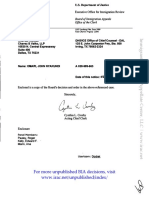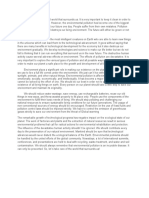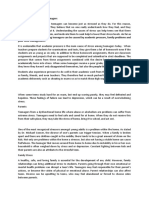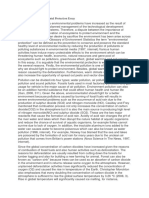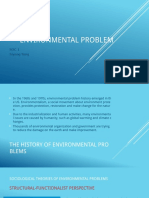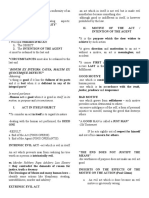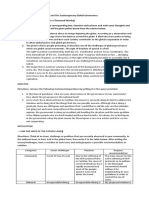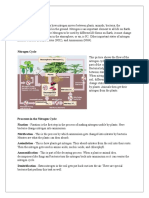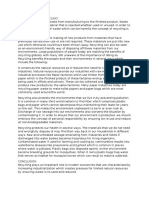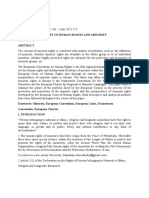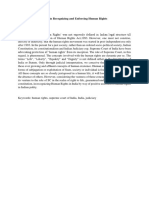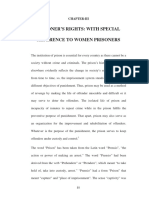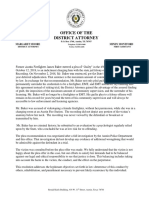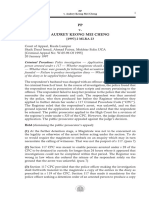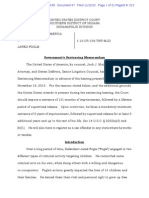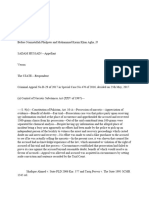100%(1)100% found this document useful (1 vote)
4K viewsEnvironment Essay
Environment Essay
Uploaded by
A.JONAH ELISA SHINYThe Environment (Protection) Act was enacted in 1986 to protect and improve the environment. It gives the central government broad powers to take measures to protect and improve environmental quality, and control pollution. Some key aspects include:
- It provides a framework for the central government to coordinate activities of various state and central authorities established under previous laws.
- The act empowers the central government to establish authorities charged with preventing and controlling pollution in air, water, and soil. It also facilitates management of chemicals and handling of hazardous substances.
- Penalties are prescribed for violations of its provisions, including imprisonment or fines. Non-compliance with regulations issued under the act may result in penalties or closure of industries.
Copyright:
© All Rights Reserved
Available Formats
Download as DOCX, PDF, TXT or read online from Scribd
Environment Essay
Environment Essay
Uploaded by
A.JONAH ELISA SHINY100%(1)100% found this document useful (1 vote)
4K views14 pagesThe Environment (Protection) Act was enacted in 1986 to protect and improve the environment. It gives the central government broad powers to take measures to protect and improve environmental quality, and control pollution. Some key aspects include:
- It provides a framework for the central government to coordinate activities of various state and central authorities established under previous laws.
- The act empowers the central government to establish authorities charged with preventing and controlling pollution in air, water, and soil. It also facilitates management of chemicals and handling of hazardous substances.
- Penalties are prescribed for violations of its provisions, including imprisonment or fines. Non-compliance with regulations issued under the act may result in penalties or closure of industries.
Original Description:
Environmental law concerning
Copyright
© © All Rights Reserved
Available Formats
DOCX, PDF, TXT or read online from Scribd
Share this document
Did you find this document useful?
Is this content inappropriate?
The Environment (Protection) Act was enacted in 1986 to protect and improve the environment. It gives the central government broad powers to take measures to protect and improve environmental quality, and control pollution. Some key aspects include:
- It provides a framework for the central government to coordinate activities of various state and central authorities established under previous laws.
- The act empowers the central government to establish authorities charged with preventing and controlling pollution in air, water, and soil. It also facilitates management of chemicals and handling of hazardous substances.
- Penalties are prescribed for violations of its provisions, including imprisonment or fines. Non-compliance with regulations issued under the act may result in penalties or closure of industries.
Copyright:
© All Rights Reserved
Available Formats
Download as DOCX, PDF, TXT or read online from Scribd
Download as docx, pdf, or txt
100%(1)100% found this document useful (1 vote)
4K views14 pagesEnvironment Essay
Environment Essay
Uploaded by
A.JONAH ELISA SHINYThe Environment (Protection) Act was enacted in 1986 to protect and improve the environment. It gives the central government broad powers to take measures to protect and improve environmental quality, and control pollution. Some key aspects include:
- It provides a framework for the central government to coordinate activities of various state and central authorities established under previous laws.
- The act empowers the central government to establish authorities charged with preventing and controlling pollution in air, water, and soil. It also facilitates management of chemicals and handling of hazardous substances.
- Penalties are prescribed for violations of its provisions, including imprisonment or fines. Non-compliance with regulations issued under the act may result in penalties or closure of industries.
Copyright:
© All Rights Reserved
Available Formats
Download as DOCX, PDF, TXT or read online from Scribd
Download as docx, pdf, or txt
You are on page 1of 14
1.What is Environment?
Give a brief overview of the
Environmental Protection Act, 1986?
An environment is the natural world which surrounds the earth and makes a particular
geographical area in which human beings, animals, plants and other living and non-living
things exist.
A clean environment is very necessary to live a peaceful and healthy life. But our environment
is getting dirty day by day because of some negligence of human beings. It is an issue which
everyone must know about especially our kids. Use following Environment Essay for your kids
and children to help them in completing their school project or essay writing competition.
Following Essay on Environment are written using very simple word and easy to understand
English Language so that your children can easy understand it.
An environment is the natural surroundings which help life to grow, nourish and destroy on
this planet called earth. Natural environment plays a great role in the existence of life on earth
and it helps human beings, animals and other living things to grow and develop naturally. But
due to some bad and selfish activities of the human beings, our environment is getting affected.
It is the most important topic that everyone must know how to protect our environment to keep
it safe forever as well as ensure the nature’s balance on this planet to continue the existence of
life.
Environment Essay 2 (150 words)
As we all are well familiar with the environment, it is everything which surrounds us naturally
and affects our daily lives on the earth. Everything comes under an environment, the air which
we breathe every moment, the water which we use for our daily routine, plants, animals and
other living things, etc around us. An environment is called healthy environment when natural
cycle goes side by side without any disturbance. Any type of disturbance in the nature’s balance
affects the environment totally which ruins the human lives.
Now, in the era of advance living standard of the human being, our environment is getting
affected to a great extent by the means of air pollution, noise pollution, deforestation, water
pollution, soil pollution, acid rain and other dangerous disasters created by the human beings
through technological advancement. We all must take an oath together to protect our natural
environment to keep it safe as usual forever.
Environment Essay 3 (200 words)
Environment means all the natural surroundings such as land, air, water, plants, animals, solid
material, wastes, sunlight, forests and other things. Healthy environment maintains the nature’s
balance as well as helps in growing, nourishing and developing all the living things on the
earth. However, now a day, some manmade technological advancement spoiling the
environment in many ways which ultimately disturbs the balance or equilibrium of nature. We
are keeping our lives in danger as well as existence of life in future on this planet.
If we do anything in wrong way out of the discipline of nature, it disturbs the whole
environment means atmosphere, hydrosphere and lithosphere. Besides natural environment, a
man made environment is also exists which deals with the technology, work environment,
aesthetics, transportation, housing, utilities, urbanization, etc. Man made environment affects
the natural environment to a great extent which we all must be together to save it.
The components of the natural environment are used as a resource however it is also exploited
by the human being in order to fulfill some basic physical needs and purpose of life. We should
not challenge our natural resources and stop putting so much pollution or waste to the
environment. We should value our natural resources and use them by staying under the natural
discipline.
Environment Essay 4 (250 words)
An environment includes all the natural resources which surround us to help in number of ways.
It provides us better medium to grow and develop. It gives us all things which we need to live
our life on this planet. However, our environment also need some help from all of us to get
maintained as usual, to nourish our lives forever and to never ruin our lives. The elements of
our environment are declining day by day because of the man made technological disaster.
We need to maintain the originality of our environment to continue the life on the earth, the
only place where life is possible till now in the whole universe. World Environment Day is a
campaign being celebrated for years every year on 5th of June in order to spread the public
awareness all over the world towards the environment safety and cleanliness. We must
participate in the campaign celebration to know the theme of celebration, to know ways of
saving our environment and to get aware about all the bad habits which declining the
environment day by day.
We can save our environment in very easy manner with the little step taken by every person on
the earth. We should reduce the amount of waste, throwing wastes properly to its place only,
stop using poly bags, reuse some old things in new ways, repair and use broken things instead
of throwing it away, see how much it would take to repair them, use rechargeable batteries or
renewable alkaline batteries, make use of fluorescent light, rain water conservation, reduce
water wastage, energy conservation, minimum use of electricity, etc.
Environment Essay 5 (300 words)
An environment is gifted by the nature to nourish the life on the earth. Everything which we
use to continue our lives comes under the environment such as water, air, sunlight, land, plants,
animals, forests and other natural things. Our environment plays a very significant role in
making possible the existence of healthy life on the earth. However, our environment is getting
worse day by day because of the manmade technological advancement in the modern era. Thus,
environmental pollution has become the biggest problem we are facing today.
Environmental pollution is affecting our daily lives negatively in various aspects of life such
as socially, physically, economically, emotionally and intellectually. Contamination of the
environment brings lots of diseases which human being may suffer whole life. It is not a
problem of community or city, it is a worldwide problem which cannot be solved by the effort
of one. If it is not addressed properly, it may end the existence of life a day. Each and every
common citizen should involve in the environmental safety programme launched by the
government.
We should correct our mistakes and selfishness towards our environment to make healthy and
safe from the pollution. It is hard to believe but true that only a little positive movements by
everyone may bring a huge change in the declining environment. Air and water pollution is
leading our health on danger by causing various diseases and disorders. Nothing can be said
healthy now a day, as what we eat is already affected by the bad effects of artificial fertilizers
which reduces and weakens our body immunity to fight disease causing microorganisms.
That’s why, anyone of us can be diseased anytime even after being healthy and happy.
So, it is a major worldwide issue which should be solved by the continuous efforts of everyone.
We should participate in the World Environment Day campaign to actively participate in the
environment safety event.
Environment Essay 6 (400 words)
All the natural things which makes life possible on the earth includes under an environment
like water, air, sunlight, land, fire, forests, animals, plants, etc. It is considered that earth is the
only planet in the universe having required environment for the life existence. Without
environment we cannot guess life here so we should keep our environment safe and clean to
ensure the life possibility in future. It is the responsibility of each and every individual living
on the earth worldwide. Everyone should come forth and join the campaign for environment
safety.
There are various cycles which happen regularly between environment and living things to
maintain the nature’s balance. However, by any means if such cycles gets disturbed, nature’s
balance also gets disturbed which ultimately affects the human lives. Our environment helps
us and other forms of existence to grow, develop and flourish on the earth for thousands of
years. As human beings are considered as the most intelligent creature made by the nature on
the earth, they have lots of eagerness to know things in the universe which lead them towards
the technological advancement.
Such technological advancement in everyone’s life put the life possibilities on the earth in
danger day by day as our environment is destroying gradually. It seems that one day it becomes
so harmful for life as the natural air, soil and water are getting polluted. Even it has started
showing its bad effects on the health of human being, animal, plants and other living things.
Artificially prepared fertilizers by using harmful chemicals are spoiling the soil which
indirectly getting collected into our body through the food we eat daily. Harmful smokes
created from the industrial companies on daily basis are polluting the natural air which affects
our health to a great extent as we breathe it every moment.
In such busy, crowded and advanced life we must take care of such types of small bad habits
on daily basis. It is true that only a small effort by the end of everyone can bring a major
positive change towards our declining environment. We should not use the natural resources
in wrong ways for just our selfishness and fulfil our destructive wishes. We should grow and
develop science and technologies for the betterment of our lives but always be sure that it would
not ruin our environment in future in anyways. We should be sure that new technologies would
never disturb the ecological balance.
THE ENVIRONMENT (PROTECTION) ACT, 1986 (EPA)
Introduction
The Environment (Protection) Act was enacted in the year 1986. It was enacted with the main
objective to provide the protection and improvement of environment and for matters connected
therewith. The Act is one of the most comprehensive legislations with pretext to protection and
improvement of environment.
The Constitution of India also provides for the protection of the environment. Article 48A of
the Constitution specifies that the State shall endeavor to protect and improve the environment
and to safeguard the forests and wildlife of the country. Article 51 A further provides that every
citizen shall protect the environment.
Premises of the Act
It is now generally accepted that environment is threatened by a wide variety of human
activities ranging from the instinctive drive to reproduce its kind to the restless urge of
improving the standards of living, development of technological solutions to this end, the vast
amount of waste, both natural and chemical, that these advances produce. Paradoxically, this
urge to grow and develop, which was initially uncontrolled is now widely perceived to be
threatening as it results in the depletion of both living and non-living natural resources and life
support systems. The air, water, land, living creatures as well as the environment in general is
becoming polluted at an alarming rate that needs to be controlled and curbed as soon as
possible.
The 1986 Act was enacted in this spirit. From time to time various legislations have been
enacted in India for this purpose. However, all legislations prior to the 1986 Act have been
specific relating to precise aspects of environmental pollution. However, the 1986 Act was a
general legislation enacted under Article 253 (Legislation for giving effect to international
agreements.—Notwithstanding anything in the foregoing provisions of this Chapter,
Parliament has power to make any law for the whole or any part of the territory of India for
implementing any treaty, agreement or convention with any other country or countries or any
decision made at any international conference, association or other body) of the Constitution,
pursuant to the international obligations of India. India was a signatory to the Stockholm
Conference of 1972 where the world community had resolved to protect and enhance the
environment.
The United Nations conference on human environment, held in Stockholm in June 1972,
proclaimed that “Man is both creator and molder of his environment, which gives him physical
sustenance and affords him the opportunity for intellectual, moral, social and spiritual growth.
In the long and tortuous evolution of the human race on this planet a stage has reached when
through the rapid acceleration of science and technology man has acquired the power to
transform his environment in countless ways and on unprecedented scale. Both aspects of
man’s environment, the natural and man made are essential to his well being and to the
enjoyment of basic human rights even the right to life itself”.
While several legislations such as The Water (Prevention and Control of Pollution) Act, 1974
and The Air (Prevention and Control of Pollution) Act, 1981 were enacted after the Conference,
the need for a general legislation had become increasingly evident. The EPA was enacted so as
to overcome this deficiency.
Objectives
As mentioned earlier, the main objective of the Act was to provide the protection and
improvement of environment and for matters connected therewith. Other objectives of
implementation of the EPA are:
To implement the decisions made at the UN Conference on Human Environment held at
Stockholm in June, 1972.
To enact a general law on the areas of environmental protection which were left uncovered by
existing laws. The existing laws were more specific in nature and concentrated on a more
specific type of pollution and specific categories of hazardous substances rather than on general
problems that chiefly caused major environmental hazards.
To co-ordinate activities of the various regulatory agencies under the existing laws
To provide for the creation of an authority or authorities for environmental protection
To provide a deterrent punishment to those who endanger human environment, safety and
health
Scope and Applicability
The Environment (Protection) Act is applicable to whole of India including Jammu & Kashmir.
It came into force on November 19, 1986.
Definitions
Section 2 of the EPA deals with definitions. Some important definitions provided in the Section
are:
Section 2 (a) “Environment” includes water, air, and land and the interrelationship that exists
among and between water, air and land and human beings, other living creatures, plants, micro-
organism and property. This definition is not exhaustive but an inclusive one.
Section 2 (b) “Environmental Pollutant” means any solid, liquid or gaseous substance present
in such concentration as may be, or tend to be injurious to environment.
Section 2 (c) “Environmental Pollution” means the presence in the environment of any
environmental pollutant6 . This implies the imbalance in environment. The materials or
substances when after mixing in air, water or land alters their properties in such manner, that
the very use of all or any of the air water and land by man and any other living organism
becomes lethal and dangerous for health.
Section 2 (e) “Hazardous Substance” means any substance or preparation which, by reasons of
its chemical or physico-chemical properties or handling, is liable to cause harm to human
beings, other living creatures, plants, micro-organism, property or environment.
Powers of Central Government to take measures to Protect and Improve Environment
According to the provisions of the Act, the Central Government shall have the power to take
all such measures as it deems necessary or expedient for the purpose of protecting and
improving the quality of the environment and preventing controlling and abating
environmental pollution. Such measures may include measures with respect to all or any of the
following matters, namely: a) co-ordination of actions by the State Governments, officers and
other authorities-
(a) under this Act, or the rules made thereunder, or
(b) under any other law for the time being in force which is relatable to the objects of this Act;
b) planning and execution of a nation-wide programme for the prevention, control and
abatement of environmental pollution;
c) laying down standards for the quality of environment in its various aspects;
d) laying down standards for emission or discharge of environmental pollutants from various
sources whatsoever: Provided that different standards for emission or discharge may be laid
down under this clause from different sources having regard to the quality or composition of
the emission or discharge of environmental pollutants from such sources;
e) restriction of areas in which any industries, operations or processes or class of industries,
operations or processes shall not be carried out or shall be carried out subject to certain
safeguards;
f) laying down procedures and safeguards for the prevention of accidents which may cause
environmental pollution and remedial measures for such accidents;
g) laying down procedures and safeguards for the handling of hazardous substances;
h) examination of such manufacturing processes, materials and substances as are likely to cause
environmental pollution;
i) carrying out and sponsoring investigations and research relating to problems of
environmental pollution;
j) inspection of any premises, plant, equipment, machinery, manufacturing or other processes,
materials or substances and giving, by order, of such directions to such authorities, officers or
persons as it may consider necessary to take steps for the prevention, control and abatement of
environmental pollution;
k) establishment or recognition of environmental laboratories and institutes to carry out the
functions entrusted to such environmental laboratories and institutes under this Act;
l) collection and dissemination of information in respect of matters relating to environmental
pollution;
m) preparation of manuals, codes or guides relating to the prevention, control and abatement
of environmental pollution;
n) such other matters as the Central Government deems necessary or expedient for the purpose
of securing the effective implementation of the provisions of this Act.
The Central Government may, if it considers it necessary or expedient so to do for the purpose
of this Act, by order, published in the Official Gazette, constitute an authority or authorities
by such name or names as may be specified in the order for the purpose of exercising and
performing such of the powers and functions (including the power to issue directions under
section (5) of the Central Government under this Act and for taking measures with respect to
such of the matters referred to in sub-section (2) as may be mentioned in the order and subject
to the supervision and control of the Central Government and the provisions of such order, such
authority or authorities may exercise and powers or perform the functions or take the measures
so mentioned in the order as if such authority or authorities had been empowered by this Act
to exercise those powers or perform those functions or take such measures.
As considerable adverse environment impact has been caused due to degradation of the
environment with excessive soil erosion and water and air pollution due to certain development
activities therefore it is necessary to protect the environment. This can be achieved only by
careful assessment of a project proposed to be located in any area, on the basis of an
environment impact assessment and environment management plan for the prevention,
elimination or mitigation of the adverse impacts, right from the inception stage of the project.
The Central Government has passed certain notifications laying that the expansion or
modernization of any existing industry or new projects listed shall not be undertaken in any
part of India, unless it gets environmental clearance by the Central Government, or the State
Government.
Powers of the Court
The Act does not curtail the powers of the Supreme Court. It has from time to time in various
matters issued directions and orders to control pollution. Some such important cases pertaining
to protection of environment are:
Directions issued to control vehicular pollution
In Mehta v Union of India (1998) 6 SCC 63, in order to control the chaotic traffic conditions
and vehicular pollution, the Supreme Court issued the following directions.
(a) All commercial/transport vehicles which are more than 20 years old should be phased out
and not permitted to ply in Delhi after October 1998
(b) All such commercial /transport vehicles which are 17 to 19 years old (3200) shall not be
permitted to ply in the National Capital Territory, Delhi after 1998;
(c) Such of the commercial /transport vehicles which are 15 and 16 years old (4962) shall not
be permitted to ply after December 31, 1998
The Supreme Court made this order applicable to all commercial/transport vehicles whether
registered in the National Capital Territory of Delhi or outside (but ply in Delhi) which are of
more than stipulated age and which do not have any authority to ply in Delhi.
Protection of Coastline of India
In Indian Council for Enviro-Legal Action v Union of India22 the Supreme Court in regard to
the 600 kms long coast line emphasized that that it would be the duty and responsibility of the
coastal states and Union Territories in which the stretch exists, to see that the notifications
issued, declaring the coastal stretches should be properly and duly implemented. Further the
various restrictions on the setting up and expansion of industries, operation or process, etc. in
the regulation Zone should be strictly enforced.
In the same case the court enunciated the principle further that the polluter pays. Once the
activity carried on is hazardous or inherently dangerous, the person carrying on such activity
is liable to make good the loss caused to any other person irrespective of the fact whether he
took reasonable care while carrying on his activity. Under this principle it is not the role of the
Government to meet the costs involved in either prevention of such damage or in carrying out
remedial action, because the effect of this would be to shift the financial burden of the pollution
incident on the taxpayer. The responsibility of repairing the damage is that of the offending
industry.
Other cases
In Vellore Citizen Welfare Forum v. Union of India & others the polluter principle as
interpreted by the Supreme Court means that the absolute liability for harm to the environment
extends not only to compensate the victims of pollution but also the cost of restoring the
environmental degradation. Remediation of the damaged environment is part of the process of
“Sustainable Development” and as such polluter is liable to pay the cost to the individual
sufferer as well as the cost of reversing the damaged ecology.
In Goa Foundation v Diksha Holdings Pvt. Ltd the court observed that with a view to protect
the ecological balance in the coastal areas, notifications having been issued by the Central
Government, there ought not to be any violation and prohibited activities should not be allowed
to come up within the area declared as CRZ notification. The court also emphasised that no
activities which would ultimately lead to unscientific and unsustainable development and
ecological destruction should be allowed.
Prevention, Control and Abetment of Environment Pollution
Chapter III of the EPA deals with prevention, Control and abetment of Environmental
Pollution. Some important provisions of this chapter provide that, No person carrying on any
industry, operation or process shall discharge or emit or permit to be discharged or emitted any
environmental pollutant in excess of such standards as may be prescribed. No person shall
handle or cause to be handled any hazardous substance except in accordance with such
procedure and after complying with such safe guards as may be prescribed. Where the
discharge of any environmental pollutant in excess of the prescribed standards occurs or is
apprehended to occur due to any accident or other unforeseen act or event, the person
responsible for such discharge and the person in charge of the place at which the discharge
occurs shall be bound to prevent or mitigate the environmental pollution. and shall also:
(a) intimate the fact of such occurrence or apprehension of such occurrence; and
(b) be bound, if called upon, to render all assistance. On receipt of such information, the
authorities or agencies shall cause such remedial measures to be taken as are necessary to
prevent or mitigate the environmental pollution.
The expenses incurred by any authority or agency may be recovered from the person concerned
as arrears of land revenue or of public demand.
Penalties
Section 15 provides for Penalties for contravention of the provisions of the Act as well as the
Rules, Orders and Directions. Whoever fails to comply with or contravenes any of the
provisions, rules, orders or directions of this Act shall be punishable with imprisonment for a
term which may extend to five years or with fine which may extend to one lakh rupees, or with
both. In case the failure or contravention continues, with additional fine which may extend to
five thousand rupees for every day during which such failure or contravention continues.
If the failure or contravention continues beyond a period of one year after the date of
conviction, the offender shall be punishable with imprisonment for a term which, may extend
to seven years. • Offences by Companies
Offences by Companies are dealt with under Section16. Where any offence is committed by a
company, every person who, at the time the offence was committed, was directly incharge of,
and was responsible to, the company for the conduct of the business of the company shall be
deemed to be guilty of the offence.
If he proves that the offence was committed without his knowledge or that he exercised due
diligence to prevent the commission of such offence he shall not be liable to any punishment.
Where the offence has been committed with the consent or connivance of or is attributable to
any neglect on part of , any director, manager, secretary or other officer of the company, such
person shall be deemed to be guilty of the offence
Cognizance of Offences and Bar of Jurisdiction of Civil Courts
As per the provisions of Section 19 of the EPA, no court shall take cognizance of any offence
under this Act except on a complaint made by:
(a) the central Government or any authority or officer authorized in this behalf by that
Government; or
(b) any person who has given notice of not less that 60 days, of the alleged offence and his
intention to make a complaint, to the Central Government or the authority or officer authorized.
Section 22 provides that no civil court shall have jurisdiction to entertain any suit or proceeding
in respect of anything done, action taken or order or direction issued by the Central Government
or any other authority or officer in pursuance of any power conferred under the Act.
The National Environment Appellate Authority
The National Environment Appellate Authority (NEAA) was set up as an independent body to
address cases in which environmental clearances granted by the ministry of environment are
challenged by civil society.
On January 30, 1997, the President of India, in exercise of the powers conferred under Article
123 (123. Power of President to promulgate Ordinances during recess of Parliament.— (1) If
at any time, except when both Houses of Parliament are in session, the President is satisfied
that circumstances exist which render it necessary for him to take immediate action, he may
promulgate such Ordinances as the circumstances appear to him to require.) of the Constitution,
promulgated an Ordinance to provide for the establishment of the NEAA to hear appeals with
respect to restriction of areas in which any industries, operations and processes shall not be
carried out or shall be carried out subject to the safeguards as provided under the EPA. The
Ordinance was later on repealed with the enactment of the National Environment Appellate
Authority Act, 1997.
The NEAA Act, which was granted presidential assent on 26th March, 1997 came into force
from 9.4.97. This Act provides for the establishment of a NEAA. The Act was enacted with
the following object:
To hear appeals with respect to restriction of areas in which any industry, operations or
processes or class of industries, operations or processes shall not be carried out or shall be
carried out subject to certain safeguards under the EPA and for matters connected therewith or
incidental thereto.
This is to bring in transparency in the process, accountability and to ensure smooth and
expeditions implementation of developmental schemes and projects. Jurisdiction of the Act
Any aggrieved person may file an appeal within thirty days of passing of an order granting
environmental clearance in the areas in which any industries, operations or processes shall not
be carried out or shall be carried out subject to certain safeguards under the EPA. It is further
provided that the Authority may entertain an appeal even after the expiry of the said term if a
sufficient cause for delay in filing such an appeal exists. The Authority is required to dispose
off the appeal within ninety days from the date of filing of the same. However, the Authority
may, for reasons that are to be recorded in writing, dispose off the appeal within a further period
of thirty days.
(2) An Ordinance promulgated under this article shall have the same force and effect as an Act
of Parliament, but every such Ordinance—
(a) shall be laid before both Houses of Parliament and shall cease to operate at the expiration
of six weeks from the reassembly of Parliament, or, if before the expiration of that period
resolutions disapproving it are passed by both Houses, upon the passing of the second of those
resolutions; and
(b) may be withdrawn at any time by the President.
Explanation.—Where the Houses of Parliament are summoned to reassemble on different
dates, the period of six weeks shall be reckoned from the later of those dates for the purposes
of this clause.
(3) If and so far as an Ordinance under this article makes any provision which Parliament would
not under this Constitution be competent to enact, it shall be void.
2.Explain International Environmental laws and various treaties
there under?
Treaties govern many aspects of international environmental law. This section lists many of
the most common multilateral treaties and indicates sources for locating treaties generally.
There is also an online Glossary of Terms for Negotiators of Multilateral Environmental
Agreements which is also in print at the Wolff Library. For more detailed information on
researching treaties -- including treaty indexes, status, updating and ratification information --
see our Treaty Research guide.
There is another genre of international environmental agreements called soft law. The Parry
and Grant Encyclopaedic Dictionary of International Law INTL REF KZ1161 .P35
2009defines soft law as "A term used to refer to non-binding instruments or documents which
have the appearance of law....While not legally binding, soft law can be politically influential
in setting down objectives and aspirations." Documents constituting soft law can often be
located on the websites of individual organizations. Examples of key soft law documents in
international environmental law include Agenda 21: Programme of Action for Sustainable
Development, the Rio Declaration on Environment and Development, and the Forest
Principles.
SELECTED ENVIRONMENTAL TREATIES AND AGREEMENTS
This list highlights some of the most frequently cited multilateral agreements related to the
environment as there are many, many environmental treaties. See EISIL's International
Environmental Law page for links to additional agreements.
Basel Convention on the Control of Transboundary Movements of Hazardous Wastes and
Their Disposal
Convention of Biological Diversity
Biosafety Protocol (Cartagena Protocol)
Convention on International Trade in Endangered Species (CITES)
Convention on the Law of the Non-Navigational Uses of International Watercourses
Framework Convention on Climate Change
International Convention for the Prevention of Pollution from Ships (MARPOL 73/78)
International Convention for the Regulation of Whaling
Kyoto Protocol to the United Nations Framework Convention on Climate Change
Law of the Sea (LOS)
Long-Range Transboundary Air Pollution
North American Agreement on Environmental Cooperation (NAFTA side agreement)
Ozone Treaties
Stockholm Convention on Persistent Organic Pollutants (POPS)
TREATY COLLECTIONS
The following resources offer collections of environmental treaties.
ECOLEX
Free database from FAO includes treaties, national legislation and court decisions. Use the
advanced search option to search by jurisdiction.
EISIL
This website is produced by the American Society of International Law and pulls together
international law by topic. The environmental section is a comprehensive collection of treaties
and includes bluebook citations under "more information" for each treaty.
Environmental Law Instruments (UNEP)
This list includes treaties from 1933 with many in pdf format.
Environmental Treaties and Resource Indicators (ENTRI)
We can't tell if this database is updated, but it does offer useful search capabilities such as by
date, number of signatories, year of entry into force and many more. Click on Treaty Locator
on the left side to access it.
Global International Waters Assessment (GIWA)
A draft map divides the world's waters into regions. By clicking on the region, you can see the
major international agreements, actors, research, state of the environment and other useful
information. Good place to start when you need to know which agreements govern which areas.
International Environmental Law : Multilateral Treaties INTL K3583.A1 I575 1974
This nine volume print looseleaf (updated regularly) is a comprehensive collection of treaties
and "soft law."
International Environmental Soft Law: Collection of Relevant Instruments INTL K3583.I58
1993
While this set has ceased updating, it offers a great collection of soft law documents.
International Freshwater Treaties Databases
This resource has nearly 450 treaties from 1820-2002. Full text is included and often citation
information is provided. There are other databases (water events, water atlas, etc) available
from the Transboundary Freshwater Dispute Database home page.
International Protection of the Environment: Conservation in Sustainable DevelopmentINTL
K3585.4.I58 1995
This multi-volume looseleaf set is updated regularly and offers a huge collection of
international environmental documents including treaties, statements, declarations, resolutions
from multiple bodies, and much more. Also has "soft law" documents.
The general treaty collections below can be very useful when you need to cite to an official
source.
HeinOnline United Nations Law Collection (Georgetown Law Only)
This collection includes the United Nations Treaty Series (UNTS) and it is easy to search. You
can even search by UNTS citation.
United Nations Treaty Collection
This database is the electronic version of the United Nations Treaty Series (UNTS). It can be
challenging to search, but it includes ratification tables and images from the print series. The
Status of Treaties is also available and includes reservations and declarations for many treaties.
You might also like
- Spot Report, Progress Report and Final ReportDocument4 pagesSpot Report, Progress Report and Final ReportAngelito Suero84% (93)
- A Critique of Aldo Leopold Land Ethic For EnvironmDocument12 pagesA Critique of Aldo Leopold Land Ethic For EnvironmNurisita M RaniNo ratings yet
- Zara HM Benetton Case Study Supplying Fast FashionDocument2 pagesZara HM Benetton Case Study Supplying Fast FashionA.JONAH ELISA SHINYNo ratings yet
- Maranan Case FolderDocument23 pagesMaranan Case FolderKate Ysabel Maranan100% (4)
- Essay On EnvironmentDocument5 pagesEssay On Environmentshanesawada67% (3)
- Affidavit of Good Moral CharacterDocument3 pagesAffidavit of Good Moral CharacterPaul Patrick S. Blanco100% (1)
- 12 29 JailphotoDocument10 pages12 29 JailphotoChris HerethNo ratings yet
- John Nyakundi Omari, A028 989 663 (BIA April 28, 2017)Document23 pagesJohn Nyakundi Omari, A028 989 663 (BIA April 28, 2017)Immigrant & Refugee Appellate Center, LLCNo ratings yet
- Environmental EssayDocument1 pageEnvironmental EssayEunice B. FadriquelanNo ratings yet
- Environment EssayDocument4 pagesEnvironment EssayDaniellehansy100% (1)
- TASK 2 Essay DeforestationDocument4 pagesTASK 2 Essay DeforestationDvya Yashu100% (3)
- Essay Enviromental IssueDocument10 pagesEssay Enviromental IssueZihad Zainal0% (1)
- I Am A Global CitizenDocument2 pagesI Am A Global CitizenJorel VanguardiaNo ratings yet
- Kohlberg's Stages of Moral Development PDFDocument15 pagesKohlberg's Stages of Moral Development PDFBryan Bab BacongolNo ratings yet
- LESSON 2B: Ancient Civilization: (Greek, Roman, and Egyptian)Document7 pagesLESSON 2B: Ancient Civilization: (Greek, Roman, and Egyptian)Kenji ToleroNo ratings yet
- Global Citizenship EssayDocument11 pagesGlobal Citizenship Essayapi-32136339367% (3)
- Addressing Environmental Probleafagah in Our School Everyone Must Consider Segregating WasteDocument2 pagesAddressing Environmental Probleafagah in Our School Everyone Must Consider Segregating WasteJoneph AparisNo ratings yet
- Effect of Media On Culture & YouthDocument3 pagesEffect of Media On Culture & YouthAbdur RehmanNo ratings yet
- Food WebDocument8 pagesFood WebjessaNo ratings yet
- Types of PollutionDocument5 pagesTypes of PollutionPooja BirajdarNo ratings yet
- Environmental AwarenessDocument2 pagesEnvironmental AwarenessVillamor Pascual Barangan Jr.No ratings yet
- Position Paper Limiting FactorsDocument14 pagesPosition Paper Limiting FactorsGabriela FernandezNo ratings yet
- Ethics - MIdterm TasksDocument10 pagesEthics - MIdterm TasksHerstine SistualNo ratings yet
- Answers Ge 10 Module 1Document8 pagesAnswers Ge 10 Module 1isagani abrilNo ratings yet
- Environmental Science: Precious H. ManingasDocument21 pagesEnvironmental Science: Precious H. Maningasprecious maningasNo ratings yet
- A3 - Climate ChangeDocument1 pageA3 - Climate ChangeMeljoySalcedoNo ratings yet
- Importance of Biodiversity To HumanDocument2 pagesImportance of Biodiversity To HumanBaxter ValNo ratings yet
- Advantage or Disadvantages of TechnologyDocument9 pagesAdvantage or Disadvantages of TechnologyFAJEROS100% (3)
- Gec 12Document2 pagesGec 12aprilmae cabusNo ratings yet
- DeontologyDocument6 pagesDeontologycyndi_xinNo ratings yet
- Causes of Stress Among TeenagersDocument4 pagesCauses of Stress Among TeenagersParimalar RathinasamyNo ratings yet
- Natural Law of TenetsDocument21 pagesNatural Law of TenetsAphrodite Molde50% (2)
- Importance of Environmental Protection EssayDocument3 pagesImportance of Environmental Protection EssaySuresh PharamasivamNo ratings yet
- Why Should I Be Moral?Document1 pageWhy Should I Be Moral?Bang BangNo ratings yet
- 7 Environmental PrinciplesDocument26 pages7 Environmental PrinciplesDaxNo ratings yet
- UTSmaterial and Ecoomic SelfDocument6 pagesUTSmaterial and Ecoomic SelfMaria AiraNo ratings yet
- Chapter IiDocument7 pagesChapter IicreshafayetteNo ratings yet
- Gabinete (2016) - That Status in Life Should Not Be A Hindrance To Academic PerformanceDocument3 pagesGabinete (2016) - That Status in Life Should Not Be A Hindrance To Academic PerformanceErika Phoebe100% (3)
- Environmental ProblemDocument12 pagesEnvironmental Problemapi-317595781No ratings yet
- Learning Activities 7Document2 pagesLearning Activities 7Rain Storm Polgadera100% (1)
- The Role of Ethics in Everyday Life - Final PaperDocument6 pagesThe Role of Ethics in Everyday Life - Final PaperMichael LamereNo ratings yet
- Determinants of MoralityDocument3 pagesDeterminants of MoralityCatherine Malabanan DizonNo ratings yet
- Rachels Cultural RelativismDocument4 pagesRachels Cultural RelativismIra DavidNo ratings yet
- The Greenhouse EffectDocument4 pagesThe Greenhouse EffectimienazNo ratings yet
- What Is Ozone LayerDocument4 pagesWhat Is Ozone LayerJoseph Gratil100% (1)
- ETHICS Class - Activity 1Document4 pagesETHICS Class - Activity 1Sonic HedgehogNo ratings yet
- GE 10 Environmental Science: Prepared By: Marygrace P. Sanopal, LPTDocument17 pagesGE 10 Environmental Science: Prepared By: Marygrace P. Sanopal, LPTVERGIE LAPINIGNo ratings yet
- Environmental ProblemsDocument3 pagesEnvironmental ProblemsElizabeth Pérez Vázquez100% (1)
- Role of Youths in Nation Building EssayDocument6 pagesRole of Youths in Nation Building Essaytitin teguh100% (1)
- What Is Ethical RelativismDocument1 pageWhat Is Ethical Relativismsubhashis87No ratings yet
- Contemporary MidtermDocument6 pagesContemporary MidtermJhon Marvin ArienzaNo ratings yet
- Intellectual Revolution ReasearchDocument2 pagesIntellectual Revolution ReasearchElaine Fiona VillafuerteNo ratings yet
- Identifying Formal and Informal VocabularyDocument2 pagesIdentifying Formal and Informal VocabularySelah TalepNo ratings yet
- 567 ArtDocument6 pages567 ArtRJ DAVE DURUHANo ratings yet
- Jonerosto M. Sinangote Ece 122Document3 pagesJonerosto M. Sinangote Ece 122NeroSinangote100% (1)
- ADVANTAGES of RECYCLING All Processes Produce Waste From Manufacturing To The Finished ProductDocument8 pagesADVANTAGES of RECYCLING All Processes Produce Waste From Manufacturing To The Finished ProductNurul Iman MaisarahNo ratings yet
- Essay #4 - Filipno ValuesDocument3 pagesEssay #4 - Filipno ValuesJohn Patrick AbergosNo ratings yet
- LM06 Filipino Youth TodayDocument4 pagesLM06 Filipino Youth TodayMeng Do TutorNo ratings yet
- Philosophical Theories About The Formation of SocietyDocument13 pagesPhilosophical Theories About The Formation of SocietybtcnresearchNo ratings yet
- Examples of Moral DilemmaDocument3 pagesExamples of Moral Dilemmagiezele ballatanNo ratings yet
- ESSAYDocument2 pagesESSAYLey Domingo Villafuerte GonzalesNo ratings yet
- Environment Speech 1Document4 pagesEnvironment Speech 1edwardbasteNo ratings yet
- Critical Analysis About Environmental Protection PSSG Rohel L. MarcianoDocument3 pagesCritical Analysis About Environmental Protection PSSG Rohel L. MarcianoKarla Joy Corpuz MarcianoNo ratings yet
- 00000Document3 pages00000chickNo ratings yet
- Essay On EnvironmentDocument4 pagesEssay On EnvironmentSHAMBO HALDERNo ratings yet
- Concept of Power, Hegemony and LegitimacyDocument29 pagesConcept of Power, Hegemony and LegitimacyA.JONAH ELISA SHINYNo ratings yet
- 16 The Non-Alignment MovementDocument17 pages16 The Non-Alignment MovementA.JONAH ELISA SHINYNo ratings yet
- Democracy and DevelopmentDocument47 pagesDemocracy and DevelopmentA.JONAH ELISA SHINYNo ratings yet
- Climate Change QuesDocument26 pagesClimate Change QuesA.JONAH ELISA SHINYNo ratings yet
- Concept of Health and DiseaseDocument7 pagesConcept of Health and DiseaseA.JONAH ELISA SHINYNo ratings yet
- Concept of Health and DiseaseDocument43 pagesConcept of Health and DiseaseA.JONAH ELISA SHINYNo ratings yet
- ArbitrationDocument16 pagesArbitrationA.JONAH ELISA SHINYNo ratings yet
- A Critical Analysis of The Biotechnology Regulatory Authority of India BillDocument9 pagesA Critical Analysis of The Biotechnology Regulatory Authority of India BillA.JONAH ELISA SHINYNo ratings yet
- European Court of Human RightsDocument19 pagesEuropean Court of Human RightsA.JONAH ELISA SHINYNo ratings yet
- Role of Media in National Development in The 21st CenturtyDocument9 pagesRole of Media in National Development in The 21st CenturtyA.JONAH ELISA SHINYNo ratings yet
- Upov Pub 295Document22 pagesUpov Pub 295A.JONAH ELISA SHINYNo ratings yet
- Freedom of Speech and Expression With Reference To Public OrderDocument45 pagesFreedom of Speech and Expression With Reference To Public OrderA.JONAH ELISA SHINYNo ratings yet
- Supreme Court of India in Recognizing and Enforcing Human RightsDocument1 pageSupreme Court of India in Recognizing and Enforcing Human RightsA.JONAH ELISA SHINYNo ratings yet
- Sustainability New Challenges PDFDocument17 pagesSustainability New Challenges PDFA.JONAH ELISA SHINYNo ratings yet
- TK StudyDocument62 pagesTK StudyA.JONAH ELISA SHINY100% (1)
- Case Analysis Name of The Case: Decided On: Citation No: Judges: 1. Assenting Judges:-2. Dissenting JudgesDocument8 pagesCase Analysis Name of The Case: Decided On: Citation No: Judges: 1. Assenting Judges:-2. Dissenting JudgesA.JONAH ELISA SHINYNo ratings yet
- CustomDocument18 pagesCustomavinishNo ratings yet
- 10 21 13 72675 Supplemental Post-Trial Motions and Supporting Declaration BWDocument18 pages10 21 13 72675 Supplemental Post-Trial Motions and Supporting Declaration BWNevadaGadflyNo ratings yet
- Government Issued ID: PLEASE INDICATE ID Number and Date of IssuanceDocument1 pageGovernment Issued ID: PLEASE INDICATE ID Number and Date of IssuanceLeanne MereriaNo ratings yet
- Title 9 Liberty and SecurityDocument23 pagesTitle 9 Liberty and SecurityGin FernandezNo ratings yet
- Prisoner'S Rights: With Special Reference To Women PrisonersDocument56 pagesPrisoner'S Rights: With Special Reference To Women PrisonersshamaNo ratings yet
- Chan Vs PeopleDocument17 pagesChan Vs PeopleEpalan Justine AngelicaNo ratings yet
- People Vs Dacuycuy 173 SCRA 90Document6 pagesPeople Vs Dacuycuy 173 SCRA 90MWinbee VisitacionNo ratings yet
- James Baker Release KVUE 2-1Document1 pageJames Baker Release KVUE 2-1Anonymous Pb39klJNo ratings yet
- Practice Test 22 - Esc 20: A. LISTENING (50 Points)Document16 pagesPractice Test 22 - Esc 20: A. LISTENING (50 Points)Tiến LêNo ratings yet
- Grenada's Data-Protection-Bill-2023 ??Document35 pagesGrenada's Data-Protection-Bill-2023 ??Michaelson BaptisteNo ratings yet
- Signed Statement of Probable Cause Jeffrey Price - RedactedDocument2 pagesSigned Statement of Probable Cause Jeffrey Price - Redactedkc wildmoonNo ratings yet
- Crim 2016 003 PDFDocument14 pagesCrim 2016 003 PDFMharisol BalaisNo ratings yet
- People v. LuceroDocument2 pagesPeople v. LuceroAilyn AñanoNo ratings yet
- 10 - Law Enforcement Operations and Planning With Crime MappingDocument218 pages10 - Law Enforcement Operations and Planning With Crime Mappingjm7052555No ratings yet
- People Vs Judge Donato G.R. No. 79269 (June 5, 1991)Document2 pagesPeople Vs Judge Donato G.R. No. 79269 (June 5, 1991)elizabethmae100% (2)
- AQA Sociology Complete Specification For AS and A2Document22 pagesAQA Sociology Complete Specification For AS and A2Bob JigginsNo ratings yet
- PP V Audrey Keong Mei ChengDocument6 pagesPP V Audrey Keong Mei ChengGS Gabrie;No ratings yet
- Jared Fogle Sentencing MemorandumDocument21 pagesJared Fogle Sentencing Memorandumsusbatt100% (1)
- The BetDocument6 pagesThe BetShahjahan KhanNo ratings yet
- Arizona Criminal Justice Commission 2012 DirectoryDocument100 pagesArizona Criminal Justice Commission 2012 DirectoryNick HentoffNo ratings yet
- Complaint Supreme 2013Document58 pagesComplaint Supreme 2013SLAVEFATHER100% (1)
- Thomas Acqnas On Political ObligationDocument19 pagesThomas Acqnas On Political ObligationBrad Dash KNo ratings yet
- Aghnoo Nagesia Vs State of Bihar On 4 May 1965Document9 pagesAghnoo Nagesia Vs State of Bihar On 4 May 1965Aman KumarNo ratings yet
- Right To Counsel-2018 M L D 1025Document8 pagesRight To Counsel-2018 M L D 1025simoncartmanbruhNo ratings yet
- G.R. No. 120988, Aug. 11, 1997: People v. Dela CruzDocument1 pageG.R. No. 120988, Aug. 11, 1997: People v. Dela CruzJaz SumalinogNo ratings yet







